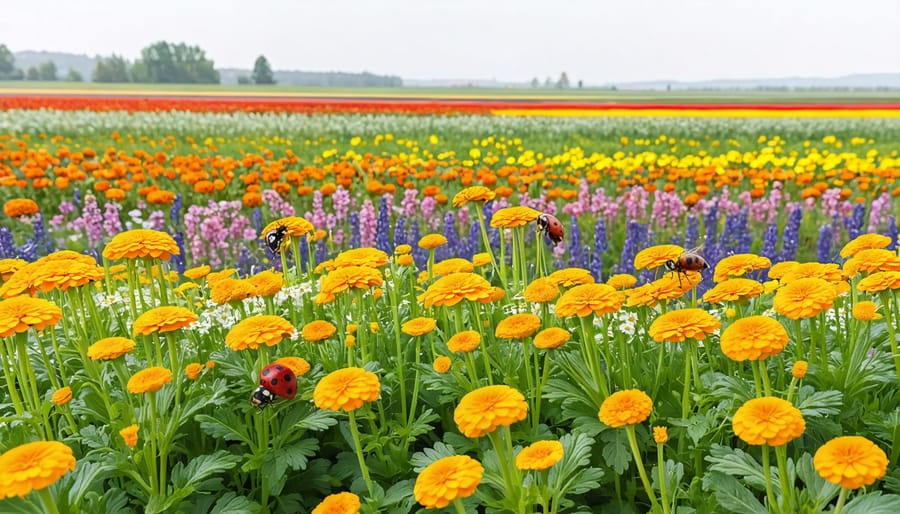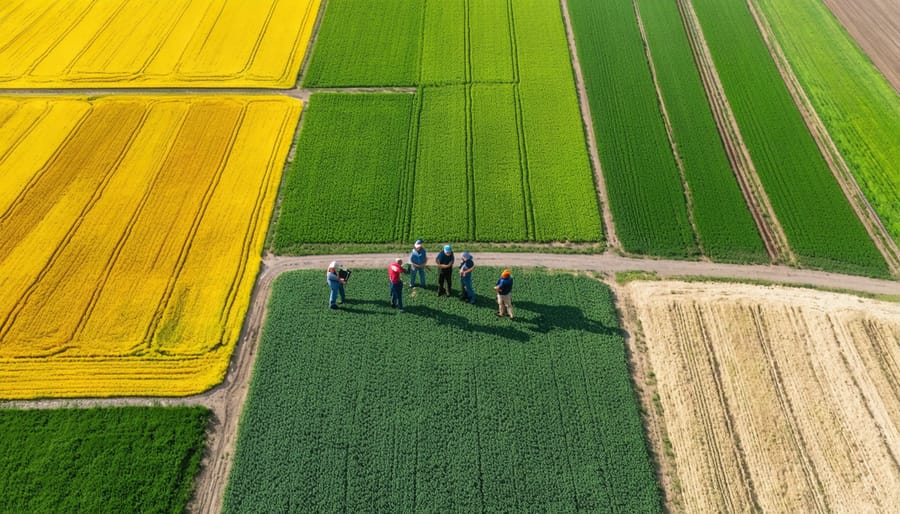Harness nature’s own defense mechanisms by introducing beneficial insects like ladybugs, lacewings, and parasitic wasps to target crop-destroying pests without chemical interventions. Deploy companion planting strategies, positioning marigolds, dill, and yarrow throughout fields to naturally repel harmful insects while attracting beneficial predators. Integrate modern pest monitoring technology with biological control methods to precisely time beneficial insect releases and maximize their effectiveness. Establish permanent hedgerows and beetle banks along field margins to create year-round habitat for beneficial organisms, ensuring sustainable pest suppression across growing seasons.
Biological pest management represents a proven shift toward resilient agriculture in Alberta, where farmers have reduced pesticide costs by 60% while maintaining crop yields through natural predator-prey relationships. This approach aligns with changing consumer preferences and strengthens farm ecosystems against climate uncertainties, positioning Canadian agriculture at the forefront of sustainable food production.
The Power of Natural Predators in Alberta Fields
Identifying Your Allies
Alberta’s farmland hosts a diverse community of beneficial insects that serve as natural pest controllers. Learning to identify these helpful allies is crucial for successful biological pest management. Lady beetles, easily recognized by their distinctive red and black coloring, are voracious aphid consumers, with both adults and larvae capable of eating up to 50 aphids per day.
Ground beetles, dark-colored and quick-moving insects active at night, patrol the soil surface, controlling cutworms and other ground-dwelling pests. Parasitic wasps, though tiny, are powerful allies that lay their eggs in or on pest insects, effectively controlling populations of cabbage loopers and armyworms.
Look for hover flies, which resemble small bees but can hover in place. Their larvae are excellent aphid predators, while adults help with pollination. Green lacewings, with their delicate, transparent wings, are another valuable predator whose larvae eagerly consume aphids, thrips, and spider mites.
Consider maintaining “insect hotels” or leaving areas of natural vegetation around field edges to provide habitat for these beneficial insects. Regular monitoring with sweep nets can help you assess the population of these helpful creatures in your fields.

Creating Predator-Friendly Habitats
Creating a welcoming environment for beneficial insects and predators is a crucial component of integrated pest management solutions. Start by establishing diverse flowering borders around your fields, incorporating native plants like yarrow, goldenrod, and asters that provide nectar and pollen throughout the growing season. These plants support predatory insects like ladybugs, parasitic wasps, and ground beetles.
Consider maintaining unmowed grass strips between crop rows, which serve as corridors for beneficial insects and provide overwintering habitat. Installing insect hotels – simple structures made from natural materials like hollow stems, wood blocks with drilled holes, and straw bundles – can provide shelter for solitary bees and predatory wasps.
Water features, even small ones, attract birds and amphibians that help control pest populations. Minimize soil disturbance in beetle banks and hedgerows to protect ground-dwelling predators. Many Alberta farmers have found success by leaving crop residue on fields during winter, creating essential shelter for beneficial insects that emerge ready to work in spring. Remember to avoid broad-spectrum pesticides that could harm these valuable allies in pest control.
Microbial Warriors in Your Soil
Bacterial Solutions
Among the most effective biological pest control methods, bacterial solutions have proven particularly successful in Canadian agriculture. Bacillus thuringiensis (Bt), a naturally occurring soil bacterium, leads the way in controlling various crop-damaging insects while maintaining ecosystem balance. When integrated with modern pest detection systems, these bacterial solutions offer precise and targeted control.
In Alberta, farmers have reported significant success using Bt-based products, particularly in canola and vegetable crops. The bacterium produces proteins that are toxic to specific pest species but harmless to beneficial insects, livestock, and humans. When pest larvae consume these proteins, they stop feeding within hours and die within 2-3 days, providing effective crop protection.
Different strains of Bt target specific pest groups: Bt kurstaki for caterpillars, Bt israelensis for mosquito larvae, and Bt tenebrionis for beetle larvae. Local studies show that rotating between these strains helps prevent resistance development while maintaining control effectiveness.
Application timing is crucial for success. Many Alberta farmers apply Bt products during early morning or evening hours when temperatures are between 15-25°C for optimal results. The bacteria remain effective for 5-7 days under typical conditions, making them a cost-effective option for sustainable pest management.
Remember to store Bt products in cool, dry conditions and follow regional guidelines for application rates to maximize their effectiveness in your specific growing conditions.

Fungal Friends
Beneficial fungi play a vital role in sustainable pest management across Alberta’s diverse agricultural landscape. These microscopic allies work tirelessly below ground and on plant surfaces, offering natural protection against harmful pests and diseases.
One of the most successful examples in our region is Trichoderma, a powerhouse fungus that Alberta grain farmers have embraced for its ability to combat root diseases in wheat and barley. This beneficial fungus actually colonizes plant roots, creating a protective shield while improving nutrient uptake and overall plant health.
Beauveria bassiana, another remarkable fungal friend, has shown impressive results in controlling grasshoppers and wireworms in canola fields. Local farmers report reduced pest pressure and improved yields when incorporating this natural solution into their management strategies.
For greenhouse operations, particularly in the Medicine Hat area, Metarhizium anisopliae has become increasingly popular for managing thrips and whiteflies. This fungus is especially effective in our climate-controlled environments, where conditions can be optimized for its performance.
Application methods are straightforward: fungi can be introduced through treated seeds, soil drenches, or foliar sprays. Many Alberta farmers start with small trial areas to observe results before scaling up. Remember that timing is crucial – early spring applications often yield the best results, allowing the beneficial fungi to establish before pest pressure builds.
These fungal solutions work best as part of an integrated approach, complementing other biological control methods while reducing the need for chemical interventions.

Companion Planting Strategies
Best Companion Plants for Alberta Crops
In Alberta’s diverse agricultural landscape, strategic companion planting can significantly enhance pest management while promoting crop health. For grain farmers, planting strips of aromatic herbs like dill and coriander between wheat rows attracts beneficial insects such as ladybugs and parasitic wasps, which naturally control aphid populations. Canola fields benefit from borders of alyssum or yarrow, which provide habitat for predatory insects that feed on flea beetles and root maggots.
For vegetable producers, interplanting carrots with onions proves highly effective, as onion’s strong scent masks the carrot smell that typically attracts carrot rust flies. Potato patches thrive when bordered by flax or horseradish, which deter potato beetles naturally. Many Alberta farmers have found success planting calendula alongside tomatoes and cole crops, as it repels various pest species while attracting pollinators.
Indigenous plants like yarrow and golden rod have demonstrated particular resilience in our climate while supporting beneficial insects. Local farming communities report that incorporating these native species not only improves pest management but also helps maintain soil moisture and reduces wind erosion.
For best results, maintain companion plantings within 3-5 metres of main crops to ensure effective pest control. Consider rotating companion plants annually alongside your main crops to prevent pest adaptation and maintain soil health. Remember that successful companion planting often requires patience, as beneficial insect populations typically take 1-2 growing seasons to establish fully.
Implementation Tips
When introducing companion plants for biological pest management, start with small test plots to observe effectiveness and interactions. Plant marigolds and nasturtiums along field edges or between crop rows, as these flowers naturally repel many common pests while attracting beneficial insects. In Alberta’s climate, aim to establish companion plants early in the growing season, ideally two to three weeks before your main crop.
Create diverse plantings by incorporating multiple species like dill, yarrow, and alyssum, which provide habitat for predatory insects. Space companion plants approximately 30-45 cm apart to ensure adequate coverage without competing with your primary crop. Consider wind patterns when planning layouts, as this affects how effectively companion plants can protect your main crops.
For larger fields, establish beetle banks – raised strips of perennial plants that provide year-round shelter for beneficial insects. Maintain these areas with minimal disturbance to protect overwintering beneficial insects. Remember to monitor and document which companion plant combinations work best for your specific situation, as effectiveness can vary based on local conditions and pest pressures.
Monitor plant health regularly and adjust spacing or species selection based on observations. This systematic approach helps develop an effective, sustainable pest management strategy tailored to your farm.
Success Stories from Alberta Farms
The Miller Family’s Transformation
The Miller family’s journey towards biological pest management began in 2018 on their 800-hectare farm near Lethbridge, Alberta. After struggling with increasing pesticide costs and resistant pest populations, Sarah and John Miller decided to make a bold shift in their farming approach.
Their transition started with introducing beneficial insects to control aphids in their canola fields. Working with local agricultural extension officers, they carefully selected parasitic wasps and ladybugs suited to the region’s climate. The Millers integrated smart farming practices to monitor pest populations and beneficial insect activity.
Within two growing seasons, they observed a 70% reduction in aphid damage while cutting their pesticide use by half. The family also implemented companion planting, growing dill and yarrow alongside their main crops to attract natural predators. Their soil health improved significantly, and beneficial insect populations established permanent colonies.
The most remarkable outcome wasn’t just pest control – their production costs decreased by 35% over three years. Today, the Millers host regular farm tours, sharing their experience with neighboring farmers. “The transition wasn’t always easy,” Sarah admits, “but seeing our land thrive while spending less on chemicals made it worthwhile. We’re proud to show others that biological pest management really works in our Alberta climate.”
Community Impact
The adoption of biological pest management has created ripple effects throughout Alberta’s farming communities, fostering collaboration and knowledge sharing among producers. Local farming cooperatives report increased engagement in pest management workshops, with experienced farmers mentoring newcomers in sustainable practices. Many communities have established beneficial insect exchange programs, where farmers share resources and expertise to maintain healthy populations of predatory insects.
In the Lethbridge region, a group of grain farmers collaborated to create a community-wide integrated pest management strategy, resulting in a 40% reduction in pest-related crop losses across participating farms. This success has inspired neighbouring communities to develop similar initiatives, creating a network of support and shared learning.
The economic benefits extend beyond individual farms. Local businesses have emerged to supply beneficial insects and support services, creating new job opportunities in rural areas. Agricultural tourism has also grown, with farms offering educational tours showcasing their biological pest management practices.
Environmental improvements have strengthened community bonds, as farmers witness collective benefits such as increased bird populations and improved pollinator activity. This shared success has led to annual celebrations like the “Beneficial Bugs Festival” in Red Deer, where farmers gather to exchange experiences and showcase their sustainable farming achievements.
These community-driven initiatives have also attracted attention from agricultural institutions, leading to increased research funding and support for biological pest management programs in Alberta.
Biological pest management represents a vital shift towards sustainable agriculture in Canada, offering farmers effective alternatives to conventional pest control methods. As we’ve explored throughout this article, these natural solutions not only protect crops but also enhance soil health, support biodiversity, and build long-term farm resilience. The success stories from Alberta farms demonstrate that biological control methods can be both practical and profitable, particularly when implemented as part of an integrated pest management strategy.
By starting small and gradually expanding biological control practices, farmers can develop systems that work best for their specific conditions. Remember that local agricultural extension offices, pest management specialists, and experienced farmers in your community are valuable resources for guidance and support. The initial investment in time and learning pays dividends through reduced input costs, improved crop quality, and enhanced environmental stewardship.
As our climate continues to change, biological pest management becomes increasingly important for sustainable food production. We encourage you to take the first step by identifying one or two practices from this guide to implement in your next growing season. Together, we can build a more resilient and sustainable agricultural future for Alberta and beyond.









